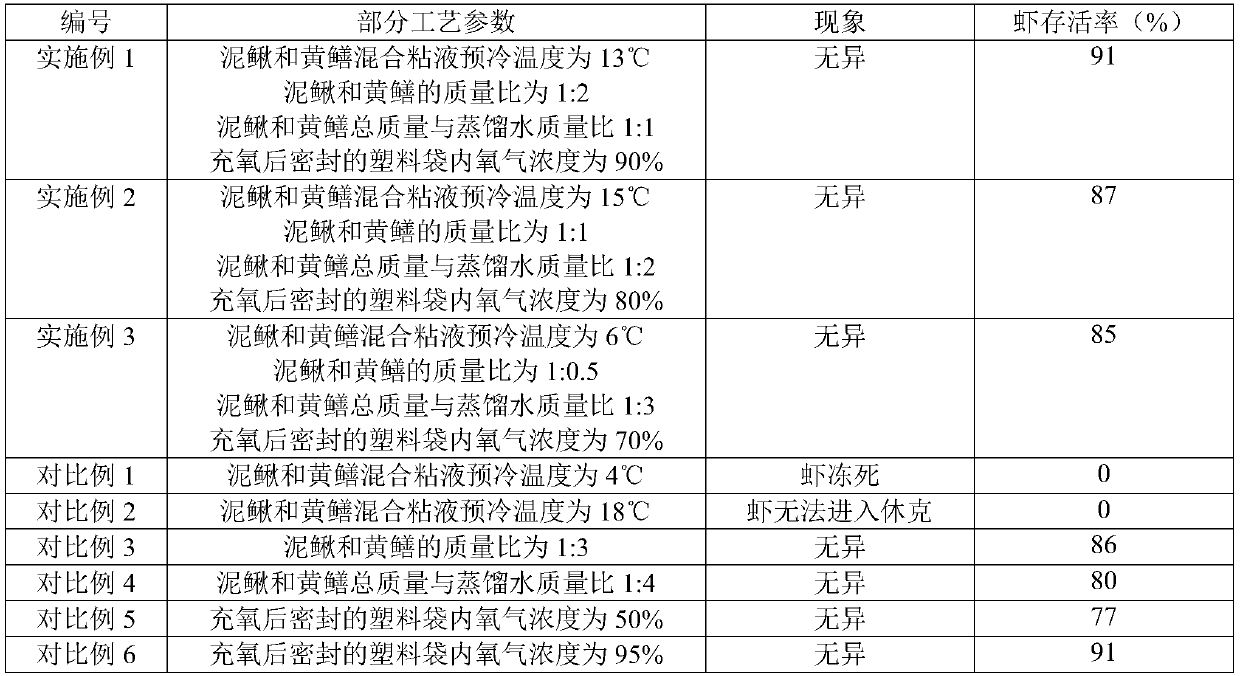Waterless keep-alive transportation method for shrimps
A technology of water-free preservation and preservation agent, which is applied in fish farming, application, climate change adaptation, etc., can solve the problems of unstable survival rate of shrimp and many influencing factors, and achieve easy breeding, alleviating stress response, The effect of maintaining the health of shrimp
- Summary
- Abstract
- Description
- Claims
- Application Information
AI Technical Summary
Problems solved by technology
Method used
Image
Examples
Embodiment 1
[0032] (1) Preparation of mixed mucus of loach and rice field eel: fresh loach and rice field eel with a mass ratio of 1:2 are washed and soaked in distilled water. Remove with a strainer, and refrigerate the remaining soaking liquid for later use;
[0033] (2) Temporary raising: the Chinese prawns after catching were stopped eating for 12 hours in clear water with a salinity of 35g / L and a water temperature of 18°C, and continuously aerated with an oxygenator;
[0034] (3) Cold shock: Put an appropriate amount of Chinese prawns in a basket, immerse them in the mixed mucus of fresh loach and rice field eel that has been pre-cooled to 13°C, and immerse for 3 minutes until all the Chinese prawns lie on their sides at the bottom of the water, and their feet move slowly and regularly to enter shock state;
[0035] (4) Packing: pull out the Chinese prawns of shock and pack into a plastic bag, then fill with oxygen and seal, and the volume concentration of oxygen in the bag is 90%;...
Embodiment 2
[0039] (1) Prepare the mixed mucus of loach and rice field eel: the fresh loach and rice field eel with a mass ratio of 1:1 are washed and soaked in distilled water. Remove with a strainer, and refrigerate the remaining soaking liquid for later use;
[0040] (2) Temporary cultivation: the caught Litopenaeus vannamei was temporarily raised in clear water with a salinity of 30g / L and a water temperature of 20°C for 24 hours, and was continuously aerated with an oxygenator;
[0041] (3) Cold shock: Put an appropriate amount of Litopenaeus vannamei into a basket, immerse in fresh loach and eel mixed with mucus pre-cooled to 15°C for 2.5 minutes, until all Litopenaeus vannamei lie on their sides and their feet move slowly and regularly. Exercise, enter a state of shock;
[0042] (4) Packing: Pull out the Shocked Litopenaeus vannamei and put it into a plastic bag, then fill it with oxygen and seal it, the volume concentration of oxygen in the bag is 80%;
[0043] (5) Transportatio...
Embodiment 3
[0046] (1) Prepare the mixed mucus of loach and rice field eel: the fresh loach and rice field eel with a mass ratio of 1:0.5 are washed and infiltrated with distilled water. Remove with a strainer, and refrigerate the remaining soaking liquid for later use;
[0047] (2) The prawns after catching were stopped eating for 14 hours in clear water with a salinity of 40g / L and a water temperature of 16°C, and continuously aerated with an oxygenator;
[0048] (3) Put an appropriate amount of Penaeus monodon in a basket, and immerse it in the mixed mucus of fresh loach and rice field eel pre-cooled to 6°C for 2 minutes, until all the Penaeus monodon lie on their side on the bottom of the water, and their feet move slowly and regularly, entering a state of shock;
[0049] (4) Pull out the Shocked Penaeus monodon and pack into a plastic bag, then fill with oxygen and seal, the volume concentration of oxygen in the bag is 70%;
[0050] (5) Anhydrous transportation is simulated in an ar...
PUM
 Login to View More
Login to View More Abstract
Description
Claims
Application Information
 Login to View More
Login to View More - R&D
- Intellectual Property
- Life Sciences
- Materials
- Tech Scout
- Unparalleled Data Quality
- Higher Quality Content
- 60% Fewer Hallucinations
Browse by: Latest US Patents, China's latest patents, Technical Efficacy Thesaurus, Application Domain, Technology Topic, Popular Technical Reports.
© 2025 PatSnap. All rights reserved.Legal|Privacy policy|Modern Slavery Act Transparency Statement|Sitemap|About US| Contact US: help@patsnap.com

